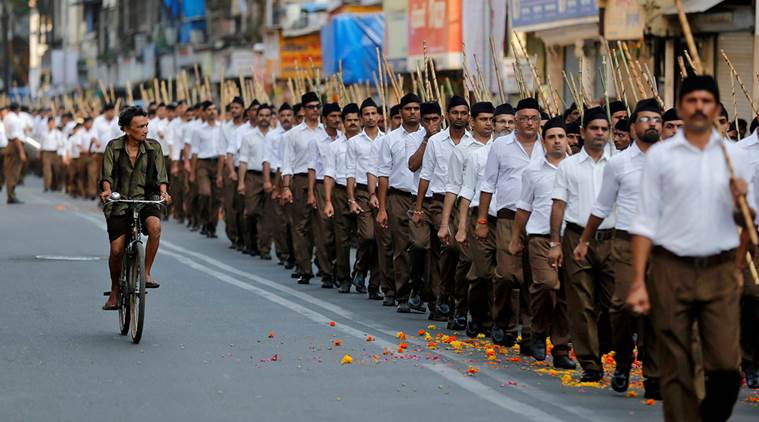In 2016, the Sangh did not like Modi’s critical remarks on Gau Rakshaks but both sides quickly covered up the chinks in their relationship and rebuilt trust.
 The Sangh is also undergoing a transformation as it pushes for social reforms, especially women and caste discrimination at a much faster pace. (Representational photo)A formidable synergy between 7, Race Course Road and Nagpur marked the third year of the Narendra Modi government. The RSS entered 2016 under a cloud after the Bihar electoral defeat with some BJP leaders attributing the debacle to Sarsanghchalak Mohan Bhagwat’s comments on reservation.
The Sangh is also undergoing a transformation as it pushes for social reforms, especially women and caste discrimination at a much faster pace. (Representational photo)A formidable synergy between 7, Race Course Road and Nagpur marked the third year of the Narendra Modi government. The RSS entered 2016 under a cloud after the Bihar electoral defeat with some BJP leaders attributing the debacle to Sarsanghchalak Mohan Bhagwat’s comments on reservation.
This year, the Sangh did not like Modi’s critical remarks on Gau Rakshaks but both sides quickly covered up the chinks in their relationship and rebuilt trust. So much so, that the RSS, despite internal disquiet and dissent over demonetisation, continued to solidly support the PM on the issue. Its UP units recently submitted a scathing report on demonetisation to their bosses, pointing out that the move might create ‘chaos and anarchy’ in the state, besides a possible electoral loss. But the RSS top brass did not take a public stand against the government.
Such has been the nature of this bond with the BJP, that the Sangh papered over the biggest revolt it has seen in its ranks in decades. Early this year, the Goa unit of the RSS, led by its president Subhash Velingkar, openly came out against the state’s BJP government and threatened to dethrone it in the upcoming polls. As worried state BJP leaders rushed to Delhi, Nagpur headquarters swiftly accommodated their concerns by sacking Velingkar, without worrying about the resignation of several hundreds of Goa’s swayamsevaks in the subsequent protests.
Contrast this with earlier instances. When Atal Bihari Vajpayee was the foreign minister during the Morarji Desai government of the late seventies, the first Pracharak in a central government, the Sangh was almost confrontationist with the regime. When Vajpayee became the PM in the late nineties, the Sangh aggressively expressed its displeasure with policies of the government it did not agree with. This time, the Sangh works assiduously to remove differences with the Modi government.
Several RSS units are working closely with top ministries. They repeatedly approached the HRD expressing their reservations on the draft education policy. In his annual Vijayadashmi address, Bhagwat also called for a review of the draft but the discussion with HRD has remained amicable.
Continuing with its growth ever since the NDA came to power, the Sangh recorded the highest ever number of shakhas across the country. While the RSS had completed 90 years last year, its women’s wing Rashtra Sevika Samiti completed the 80 years in 2016.
The Sangh is also undergoing a transformation as it pushes for social reforms, especially women and caste discrimination at a much faster pace. For an organisation accused of focusing on its Brahmincal order, one that first publicly termed Untouchability a ‘sin’ as late as in 1970s, this marks a major shift when its top brass now talk about one burial ground, one temple and one well for everyone. Its ambitious goal now is to ensure that in the next five years every shakha emerges as the nucleus of social transformation in that area.
For all this, the Sangh was rocked by a controversy surrounding ‘trafficking’ of girl child by some of its members. The RSS also saw the return of Sahsarkaryavah. Suresh Soni, named in Vyapam scam, after a long break. Known for his superior organising capabilities, one of Soni’s new tasks have been to enhance synergies with the government.
This year also saw Sarkaryavah Bhaiyyaji Joshi’s repeated appeals to allow him to go on long leave but he was convinced to stay on. Number two in the Sangh ranks, Joshi oversees the daily functioning whereas Bhagwat functions as a ceremonial head.
The Sangh enters 2017, a major electoral year, with challenges in UP and Gujarat. Having posted one of its most qualified man Sahsarkaryavah Dattatreya Hosabale in Lucknow, its Swayamsevaks will now decide the route map to 2019.http://indianexpress.com/article/opinion/web-edits/in-2016-rss-grew-in-importance-and-closer-to-modi-govt-4451629/